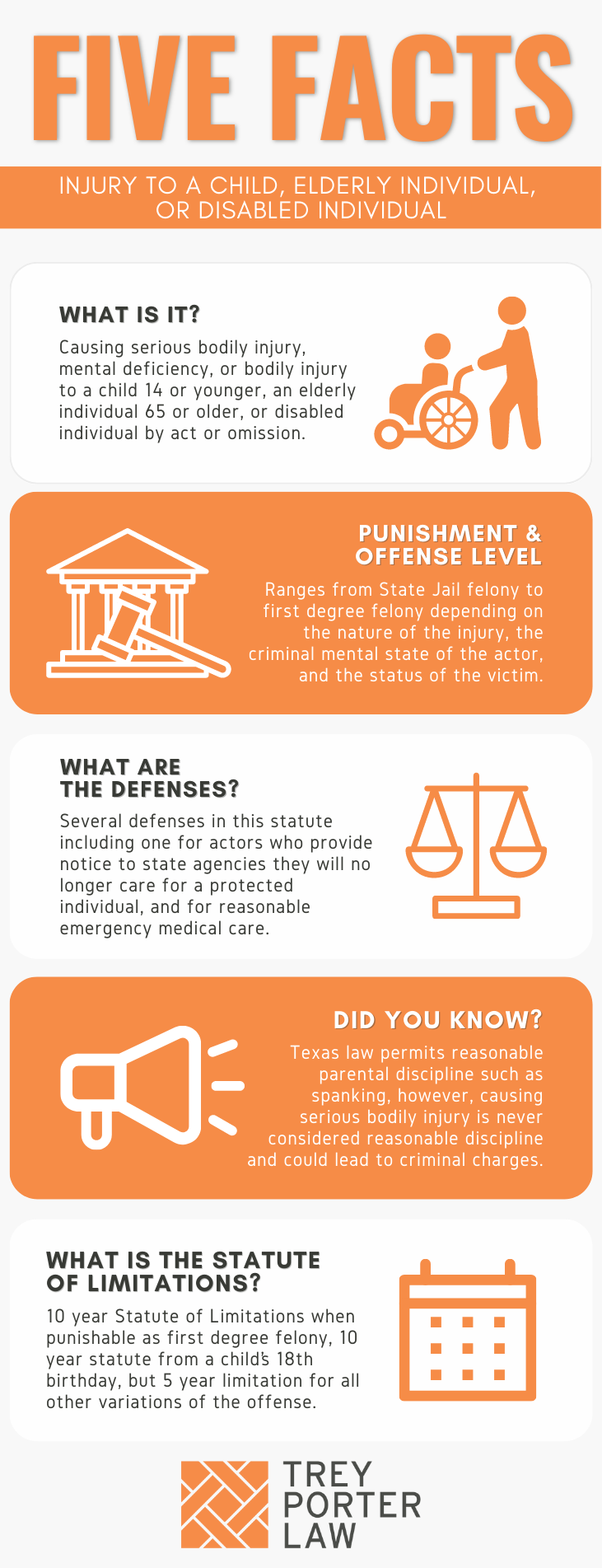WHAT IS INJURY TO A CHILD, ELDERLY INDIVIDUAL, OR DISABLED INDIVIDUAL IN TEXAS?
The Texas law against injury to a child, elderly individual, or disabled individual prohibits causing serious bodily injury or mental injury to a child younger than 14, an elderly person 65 years or older, or a mentally or physically disabled person. This crime may be committed, like most crimes, through a voluntary act, but a person may also be penalized for failing to take reasonable, legally required actions—i.e., “by omission.”

- What is injury to a child, elderly individual, or disabled individual by omission?
Injury by omission requires the person responsible to either have a legal or statutory duty to act for the protected individual, or the person must have assumed care, custody, or control prior to their failure to act. The most common example of injury to a child by omission is when a parent or guardian of a child fails to provide necessary nourishment or medical care for the child. In addition to parents, the law requires nannies, stepparents, grandparents, or any other person who has assumed responsibility for the child to act in the child’s best interest.
WHAT IS THE INJURY TO A CHILD, ELDERLY INDIVIDUAL, OR DISABLED INDIVIDUAL LAW IN TEXAS?
Tex. Penal Code § 22.04. INJURY TO A CHILD, ELDERLY INDIVIDUAL, OR DISABLED INDIVIDUAL.
(a) A person commits an offense if he intentionally, knowingly, recklessly, or with criminal negligence, by act or intentionally, knowingly, or recklessly by omission, causes to a child, elderly individual, or disabled individual:
(1) serious bodily injury;
(2) serious mental deficiency, impairment, or injury; or
(3) bodily injury.
(a-1) A person commits an offense if the person is an owner, operator, or employee of a group home, nursing facility, assisted living facility, boarding home facility, intermediate care facility for persons with an intellectual or developmental disability, or other institutional care facility and the person intentionally, knowingly, recklessly, or with criminal negligence by omission causes to a child, elderly individual, or disabled individual who is a resident of that group home or facility:
(1) serious bodily injury;
(2) serious mental deficiency, impairment, or injury; or
(3) bodily injury.
(b) An omission that causes a condition described by Subsection (a)(1), (2), or (3) or (a-1)(1), (2), or (3) is conduct constituting an offense under this section if:
(1) the actor has a legal or statutory duty to act; or
(2) the actor has assumed care, custody, or control of a child, elderly individual, or disabled individual.
. . .
(d) For purposes of an omission that causes a condition described by Subsection (a)(1), (2), or (3), the actor has assumed care, custody, or control if the actor has by act, words, or course of conduct acted so as to cause a reasonable person to conclude that the actor has accepted responsibility for protection, food, shelter, or medical care for a child, elderly individual, or disabled individual. For purposes of an omission that causes a condition described by Subsection (a-1)(1), (2), or (3), the actor acting during the actor’s capacity as owner, operator, or employee of a group home or facility described by Subsection (a-1) is considered to have accepted responsibility for protection, food, shelter, or medical care for the child, elderly individual, or disabled individual who is a resident of the group home or facility.
(e) An offense under Subsection (a)(1) or (2) or (a-1)(1) or (2) is a felony of the first degree when the conduct is committed intentionally or knowingly. When the conduct is engaged in recklessly, the offense is a felony of the second degree.
(f) An offense under Subsection (a)(3) or (a-1)(3) is a felony of the third degree when the conduct is committed intentionally or knowingly, except that an offense under Subsection (a)(3) is a felony of the second degree when the conduct is committed intentionally or knowingly and the victim is a disabled individual residing in a center, as defined by Section 555.001, Health and Safety Code, or in a facility licensed under Chapter 252, Health and Safety Code, and the actor is an employee of the center or facility whose employment involved providing direct care for the victim. When the conduct is engaged in recklessly, the offense is a state jail felony.
(g) An offense under Subsection (a) is a state jail felony when the person acts with criminal negligence. An offense under Subsection (a-1) is a state jail felony when the person, with criminal negligence and by omission, causes a condition described by Subsection (a-1)(1), (2), or (3).
(h) A person who is subject to prosecution under both this section and another section of this code may be prosecuted under either or both sections. Section 3.04 does not apply to criminal episodes prosecuted under both this section and another section of this code. If a criminal episode is prosecuted under both this section and another section of this code and sentences are assessed for convictions under both sections, the sentences shall run concurrently.
(i) It is an affirmative defense to prosecution under Subsection (b)(2) that before the offense the actor:
(1) notified in person the child, elderly individual, or disabled individual that the actor would no longer provide the applicable care described by Subsection (d), and notified in writing the parents or a person, other than the actor, acting in loco parentis to the child, elderly individual, or disabled individual that the actor would no longer provide the applicable care described by Subsection (d); or
(2) notified in writing the Department of Family and Protective Services that the actor would no longer provide the applicable care described by Subsection (d).
(j) Written notification under Subsection (i)(2) or (i)(3) is not effective unless it contains the name and address of the actor, the name and address of the child, elderly individual, or disabled individual, the type of care provided by the actor, and the date the care was discontinued.
(k) It is a defense to prosecution under this section that the act or omission consisted of:
(1) reasonable medical care occurring under the direction of or by a licensed physician; or
(2) emergency medical care administered in good faith and with reasonable care by a person not licensed in the healing arts.
(l) It is an affirmative defense to prosecution under this section:
(1) that the act or omission was based on treatment in accordance with the tenets and practices of a recognized religious method of healing with a generally accepted record of efficacy;
(2) for a person charged with an act of omission causing to a child, elderly individual, or disabled individual a condition described by Subsection (a)(1), (2), or (3) that:
(A) there is no evidence that, on the date prior to the offense charged, the defendant was aware of an incident of injury to the child, elderly individual, or disabled individual and failed to report the incident; and
(B) the person:
(i) was a victim of family violence, as that term is defined by Section 71.004, Family Code, committed by a person who is also charged with an offense against the child, elderly individual, or disabled individual under this section or any other section of this title;
(ii) did not cause a condition described by Subsection (a)(1), (2), or (3); and
(iii) did not reasonably believe at the time of the omission that an effort to prevent the person also charged with an offense against the child, elderly individual, or disabled individual from committing the offense would have an effect; or
(3) that:
(A) the actor was not more than three years older than the victim at the time of the offense; and
(B) the victim was a nondisabled or disabled child at the time of the offense.
(m) It is an affirmative defense to prosecution under Subsections (a)(1), (2), and (3) for injury to a disabled individual that the person did not know and could not reasonably have known that the individual was a disabled individual, as defined by Subsection (c), at the time of the offense.
Tex. Penal Code § 9.61. PARENT-CHILD.
(a) The use of force, but not deadly force, against a child younger than 18 years is justified:
(1) if the actor is the child’s parent or stepparent or is acting in loco parentis to the child; and
(2) when and to the degree the actor reasonably believes the force is necessary to discipline the child or to safeguard or promote his welfare.
Tex. Penal Code § 9.63. GUARDIAN-INCOMPETENT.
The use of force, but not deadly force, against a mental incompetent is justified:
(1) if the actor is the incompetent’s guardian or someone similarly responsible for the general care and supervision of the incompetent; and
(2) when and to the degree the actor reasonably believes the force is necessary:
(A) to safeguard and promote the incompetent’s welfare; or
(B) if the incompetent is in an institution for his care and custody, to maintain discipline in the institution.
WHAT IS THE PENALTY CLASS FOR INJURY TO A CHILD, ELDERLY INDIVIDUAL, OR DISABLED INDIVIDUAL IN TEXAS?
The penalty classification for injury to a child, elderly individual, or disabled individual depends on the accused’s intent, and the severity of the injury.
- First degree felony, punishable by five to 99 years or life in prison, if a person:
- intentionally or knowingly causes serious bodily injury, or serious mental deficiency, impairment, or injury to a child, elderly individual, or disabled individual.
- Second degree felony, punishable by two to 20 years in prison, if:
- a person recklessly causes serious bodily injury, or serious mental deficiency, impairment, or injury to one of those protected individuals; or
- an employee of a state-supported living center intentionally or knowingly causes bodily injury to a disabled individual residing at the center.
- Third degree felony, punishable by two to ten years in prison, if a person:
- intentionally or knowingly causes bodily injury to a child, elderly individual, or disabled individual.
- State jail felony, punishable by 180 days to two years in a state jail facility, if a person:
- recklessly causes bodily injury to a child, elderly individual, or disabled individual, or causes any level of injury with criminal negligence, by omission.
WHAT IS THE PUNISHMENT RANGE FOR INJURY TO A CHILD, ELDERLY INDIVIDUAL, OR DISABLED INDIVIDUAL IN TEXAS?
The punishment range for injury to a child, elderly individual, or disabled individual depends on the person’s act or omission, intent, and severity of injury to the victim.
- First degree felony (five to 99 years or life in prison, maximum fine of $10,000):
- intentionally or knowingly causing serious bodily injury, or serious mental deficiency, impairment, or injury;
- Second degree felony (two to 20 years in prison, maximum fine of $10,000):
- recklessly causing serious bodily injury, or serious mental deficiency, impairment, or injury, or
- an employee of a state-supported living center intentionally or knowingly causes bodily injury to a disabled individual residing at the center;
- Third degree felony (two to ten years in prison, maximum fine of $10,000):
- intentionally or knowingly causing bodily injury;
- State jail felony (180 days to two years in a state jail facility, maximum fine of $10,000):
- recklessly causing bodily injury, or
- causing any level of injury with criminal negligence, by omission.
WHAT ARE THE PENALTIES FOR INJURY TO A CHILD, ELDERLY INDIVIDUAL, OR DISABLED INDIVIDUAL IN TEXAS?
A person charged with injury to a child, elderly individual, or disabled individual may be eligible for probation after a conviction, or deferred adjudication without a conviction.
The period of community supervision for a first degree felony, second degree felony, or third degree felony may not exceed ten years. The community supervision term for a state jail felony may range from two to five years, with the possibility of extending supervision for up to ten years.
Pursuant to Article 42A.054 of the Texas Code of Criminal Procedure, a person charged with first degree felony injury to a child is not eligible for probation from a judge, but may receive probation from a jury if the person has no prior felony convictions, and the jury’s sentence does not exceed ten years.
A person charged with a first degree felony intentional injury to a child may only receive deferred adjudication from a judge after a plea of guilty or nolo contendere (“no contest”) for a maximum period of ten years.
WHAT ARE THE DEFENSES TO INJURY TO A CHILD, ELDERLY INDIVIDUAL, OR DISABLED INDIVIDUAL IN TEXAS?
In addition to the justification defenses available for most crimes, there are several affirmative defenses listed in the statute. Among other defenses, the statute expressly provides that it is an affirmative defense to failing to report an injury if there is no evidence that the person knew the protected individual was injured. The statute also creates an affirmative defense for injury to a child if the person charged was three years older or less than the injured child. Additional defenses include:
- What is the “notification” affirmative defense to injury to a child, elderly individual, or disabled individual in Texas? A person may give effective notice to both the protected individual and their parent or other guardian, or the Department of Family and Protective Services (formerly CPS), that the person will no longer provide care to the protected individual.Notice must be given to the protected individual in person and in writing to the parents or other caregiver of the protected individual, or in writing to the Department of Family and Protective Services. If effective notice is given prior to the act or omission causing the injury, the person may raise this affirmative defense.
- What is the Good Samaritan defense to injury to a child, elderly individual, or disabled individual? The Good Samaritan defense in Texas Penal Code Section 22.04(k) is available if the act or omission consisted of: (1) reasonable medical care under the direction of or by a licensed physician; or (2) emergency medical care administered in good faith and with reasonable care by a person not licensed in the healing arts.For example, injuring a child while performing CPR, with the requisite good faith and reasonable care, could entitle a person to a Good Samaritan defense.
- What if the accused was a victim of family or domestic violence when the child’s injury occurred? Texas Penal Code Section 22.04(l)(2) gives victims of family violence a defense to failing to prevent a child’s injury. The person must not have acted in a way that caused the child’s injury, and must have reasonably believed he or she could not prevent another from causing the child’s injury.For example, if a husband is assaulting his wife while she is holding their child, and the wife—a victim of domestic abuse—does not reasonably believe she can prevent the husband from injuring the child, the wife should not be prosecuted for any resulting injuries to the child. The husband, however, could be prosecuted.
- Can accidental conduct constitute injury to a child, elderly individual, or disabled individual? Purely accidental conduct is not a crime if it does not rise to the level of criminal negligence. In McKay v. State, a two-year-old lived with her mother and her mother’s boyfriend. While the boyfriend was babysitting, he was boiling water in the kitchen. With the pot in his hands, he turned around without knowing the child had come into the kitchen, and spilled hot water down the two-year-old’s back. The Court of Criminal Appeals held the defendant’s conduct did not create a “substantial and unjustifiable risk” such that it rose to criminal negligence.
- Is disciplining a child a crime? Texas Penal Code Section 9.61 and the Texas Family Code permit parents and guardians to reasonably discipline their children. However, if corporal punishment, such as spankings, go beyond “reasonable discipline,” it may constitute a crime. Causing serious bodily injury is not, under any circumstances, reasonable discipline. To wholly avoid criminal charges, parents should use caution and restraint when deciding whether to spank or hit their children.In Thompson v. State, the defendant was a pastor at a church, who beat the 11-year-old victim with a tree branch at least 100 times for misbehaving in Bible study. This led to hypovolemic shock, and nearly killed the child. The defendant was convicted of first degree felony injury to a child.He argued on appeal he only intended to cause bodily injury, not serious bodily injury, so the injury should have been a third degree. The Court of Criminal Appeals affirmed, holding his mistake-of-fact defense did not negate transferred intent, so he was criminally responsible for foreseeable results.
WHAT IS THE STATUTE OF LIMITATIONS FOR INJURY TO A CHILD, ELDERLY INDIVIDUAL, OR DISABLED INDIVIDUAL IN TEXAS?
The limitation period for first degree felony injury to an elderly or disabled individual is ten years. The limitation period for injury to a child is ten years from the injured child’s 18th birthday. If it is charged as anything other than a first degree felony, the limitation period is five years.
INJURY TO A CHILD, ELDERLY INDIVIDUAL, OR DISABLED INDIVIDUAL IN TEXAS
Injury to a child, elderly individual, or disabled individual covers a wide range of conduct. If a person causes physical or mental injury to one of those protected individuals—other than by pure accident—it is possible to be charged with a crime. A person responsible for a protected individual’s care may also be charged with injury by omission if the person fails to adequately care for the individual.
TEXAS INJURY TO A CHILD, ELDERLY INDIVIDUAL, OR DISABLED INDIVIDUAL COURT CASES
The case law in Texas regarding injury to a child, elderly individual, or disabled individual illustrates the statute’s application.
- What is an example of injury to a child by omission? In Proo v. State, a healthy five-year-old child moved in with his father, step-mother, and step-grandmother. Six months later, he died of dehydration, malnutrition, and head trauma. All three adults were convicted of failing to provide adequate nourishment and medical care for the child. The step-grandmother appealed, but the appellate court found she had assumed care, custody, and control of the child by watching him on numerous occasions. By failing to care for the child, she caused serious bodily injury and death to the child by omission.
- Can one be charged with injuring or killing an unborn child? Texas courts have held that a pregnant woman who uses drugs during pregnancy may not be charged with injury to a child. See, e.g., Collins v. State, 890 S.W.2d 893 (Tex. App.—El Paso 1994, no pet.). The Texas Legislature codified this judicial decision, enacting Section 22.12 of the Penal Code in 2003. A mother who uses drugs or other substances during pregnancy cannot be charged with injury to a child.But in Cuellar v. State, the defendant was convicted for intoxication manslaughter after crashing into a pregnant woman’s car. When the woman was rushed to the hospital, doctors delivered a live baby who died shortly thereafter from injuries caused by the crash. The appellate court upheld his conviction.
















